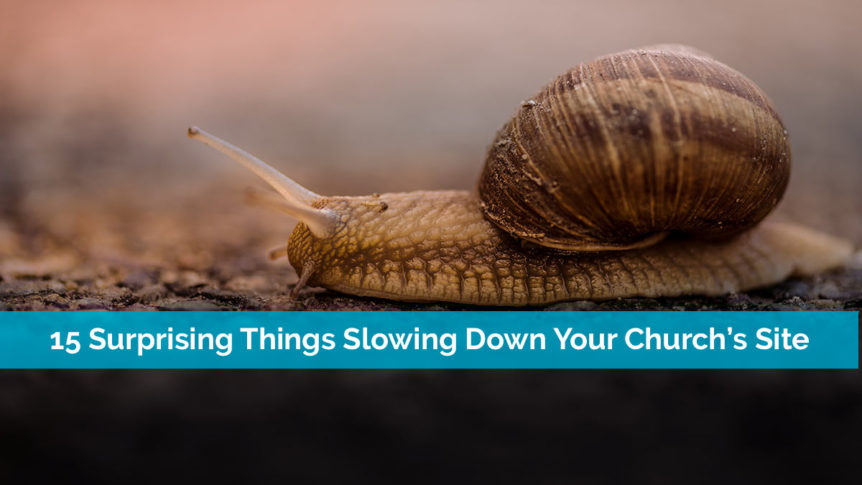Your site’s performance is just as important as the content. If there are things slowing down your church’s site, visitors might not stick around long enough to view or read anything.
The bad part is it can be something incredibly simple preventing your site from loading as fast as it should. Or, it may be a more complex issue.
The main thing is to discover the problem and fix it as soon as possible. The faster your site loads and the fewer errors visitors encounter, the better your site will perform overall.

Test Your Site Speed
The first step is to check how quickly your church’s site loads. If you’re lucky, you may already be doing everything right and you don’t need to read any further. Don’t worry, there are plenty of free tools to help you quickly check site loading speeds.
You can also speak to your members, which is a good idea anyway. They’re likely accessing your site from various devices and browsers. It’s always possible for your site to work better on one device over another, such as between mobile and desktop.
If you don’t think speed is such a big deal, consider the fact that 64% of mobile visitors expect your site to load within four seconds. Additional seconds can result in an 11% loss in views per second. A faster site can increase organic traffic by up to 20%. So, it’s well worth finding out what’s slowing down your church’s site.
Try one or more of these tools to check performance for yourself:
- Google PageSpeed Insights
- Pingdom (test speed for different areas of the world too)
- GTmetrix (free and premium versions available)
- KeyCDN (more detailed insights)
1. Images Too Big
When you’re busy taking pictures on your phone, you don’t really give the file size any real thought. However, the larger your image files are, the longer it takes for a page to load.
Images are usually one of the top things slowing down your church’s site. But, don’t start removing all your images. Instead, optimize them. It’s not unusual for an image from your phone to be several megabytes or more in size. Ideally, images on your website should be less than a megabyte.
Overall, the smaller the file size, the better. However, ensure that the image still looks good on all devices. Also, stick to commonly used formats, such as JPG, GIF (moving GIFs do take longer to load though) and PNG. These file formats load faster than others.
2. Shared Website Hosting
You could optimize your church’s site until it’s perfect, but why is it still so slow? The problem could be your host or your hosting type. Check to see what kind of bandwidth your host is allocating to your site. Also, if they’re using outdated equipment, it’s your site that suffers.
Another problem is shared website hosting. Multiple sites are hosted on the same server. This means they share the resources. If you’re sharing space with several busy sites, your church’s site might get left with minimal resources and a terrible experience for your visitors.
While shared hosting is cheaper, make sure that resources are allocated fairly among all sites.
3. Messy Coding
Your church’s site works and that’s all that matters right? Wrong! Millions of lines of code power websites. In fact, Google’s various sites and services are powered by over two billion lines of code.
Now, imagine if that code isn’t organized correctly. The more messy and clunky the code is, the longer it takes for a browser to turn it into your website. Often times, clunky code is just poorly written code, such as using JavaScript that can interfere with other parts of your site.
There are a variety of ways to decrease the amount of code, optimize code, combine sections and even reorganize elements to load web pages faster. You can also eliminate older features, such as Flash and iFrames. It’s also important to note that if you don’t organize your code correctly, search engines might not see your site the way you want them to.
Minifying plugins are designed to optimize code and even reduce the number of requests, making your code load faster in browsers.

4. Skipping Compression
When you want to send multiple files at once, you often compress them in a single folder to make it easier and faster to send. You can do something similar with your website. Compression tools allow you to compress the size of your image and other site-related files. The result is a much faster loading site.
It’s important to use tools made for this purpose. Simply zipping a folder won’t work quite the same way when it comes to a browser reading your site data. If you’re using WordPress, free compression plugins work well to give your site a nice boost.
5. Server Location (Use a CDN)
One of the most surprising things that may be slowing down your church’s site is the server location. For instance, if your website is being hosted on a server in Los Angeles, but much of your traffic is coming from Miami, your Miami visitors might not get the same page loading speeds as your Los Angeles visitors.
This is where a CDN, or content delivery network, helps. The most simple explanation is a CDN is a group of servers throughout the world where cached versions of your site’s content reside. When someone visits your site, content is delivered to them from the closest geographical server.
If you’re interested in diving into the more technical aspects, Cloudflare and SitePoint do a great job of explaining exactly how CDNs work and how they benefit your site.
6. Too Much Traffic (That’s A Good Thing)
First of all, congratulations! All that great content and site marketing has paid off and now you’re getting a bunch of new traffic to your church’s site. However, too much traffic might be a problem too.
Usually, your web hosting plan is designed for a certain amount of traffic. Even unlimited plans may still slow down if you have sudden bottlenecks. If this is the case, you may need to upgrade to a higher performance plan or even switch to a web host for busier sites.
The last thing you want is to suddenly get the traffic you’ve been working hard for only to give all those new visitors a bad first impression.
7. Hosting Videos Directly On Your Site
Of all the things slowing down your church’s site, videos can be the worst. This is especially true with autoplay videos. A good rule of thumb – skip the autoplay. Many people keep their device volume silent just because of this trend.
If large images slow down your page, it only serves to reason that those much larger video files will slow things down even more. There are two ways to solve this issue.
First, if you’re hosting the videos directly on your site, don’t place them all on your homepage. A single video on the homepage works well without bogging things down too much. If you’re hosting numerous videos, such as past sermons, give them a dedicated page so visitors know to expect longer page load times due to the videos.
The second option is to embed videos versus hosting them directly. For instance, many sites embed YouTube videos. The videos live on YouTube, but you’re creating a link to them through the embed. Your site loads faster, but still has videos. You can place videos on YouTube or other platforms, even third-party storage sites.

8. Too Many Wonderful Plugins
Plugins let you do so much more with your website. When it comes to WordPress, some plugins are necessary, such as security, SEO and anti-spam. However, the more plugins you’re using on your site, the longer it takes for the site to load.
The bad thing is it’s easy to want to add more. It’s even worse when you hold on to a large collection of plugins that you don’t even actively use anymore.
Not only do excess plugins take up valuable page loading time, but they’re dangerous. In fact, outdated plugins are one of the top security vulnerabilities for WordPress sites.
9. Competing With Cached Copies
Browsers try to speed things up for users by caching a static copy of your site on the local machine. The only problem is any optimizations you make end up competing with these cached copies.
Using caching plugins helps to clear browser caches and creates a static HTML version of your site using your own site’s optimizations. This speeds up page loading times. Plus, visitors get custom cached versions based on their actions on your site, such as being logged in.
10. Using Redirects
If you’ve re-designed your church’s site, you might have used redirects to make it easier to handle any content you’ve moved around. However, instead of visitors having to wait for a single page to load, they’re having to wait for two pages.
Each redirect increases how long it takes for visitors to get to their destination. Anytime you can eliminate these, you’ll improve the visitor experience. It’s okay to do this on some pages, but try to avoid this on frequently visited pages.
11. Outdated Site Features
Would you really want to try to run the newest software on a Windows 98 system? Probably not. If you’re using outdated site features, your site won’t work as well on modern browsers and devices. For instance, if you use Flash, those elements of your site may not even load on many devices, especially mobile.
Updating your site with newer features and a more modern design helps it to run smoother and faster.

12. Outdated CMS
An outdated CMS, or content management system, is just as bad. The most commonly used CMS is WordPress, but it’s not the only one. No matter which one you’re using, keep it up to date. Newer features and security updates are released regularly to boost your site’s performance and keep visitors safe.
13. Excess Website Database Items
One of the more surprising things slowing down your church’s site is probably something you don’t even look at – database items. All the files, logs and other data are stored in databases in your site. However, you don’t need all of it.
Computers utilize clean-up tools to remove excess files that reduce performance. Websites have similar tools, but it’s often best to use a website maintenance service at least a few times a year to purge excess files and boost your site’s performance.
14. Having Too Many Elements
The more elements you have on your site, the longer it takes to load. This often happens as you add new things or change the style. In many cases, the code behind your site can be changed to combine element files, such as CSS (the code sections that specify the style and look of your site).
Anytime you can effectively combine and reduce the number of individual elements that have to load, the faster everything will be for your visitors.
15. Not Optimizing For Mobile
A mobile-friendly church site isn’t just a fad. In fact, it’s so important now that Google may exclude your site from search results on mobile devices. When it comes to mobile devices, one of the top things slowing down your church’s site could be that it’s not optimized for mobile.
You can’t load the exact same version of your site on desktops and mobile devices. The two types of devices don’t have the same hardware and software. This means what loads fast on a desktop may take much longer on mobile.
Using a responsive design helps you to strip down some of the excess when your site loads on a mobile device. It also optimizes areas of your site and changes the order in which things are loaded so your site appears just as fast on a smartphone as a desktop.
You can even create a separate mobile version of your site, but that will mean you’ll need to maintain two sites. Even if you have a mobile app, your church’s site still needs to be optimized for mobile as people will likely find your site before your app.
Need a newer, faster church website? Contact us today to learn how we can build an optimized site that loads fast and impresses visitors.




